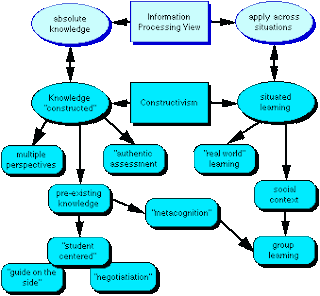Founded by one of the grandfathers (Piaget)
of educational theories, constructivism is a theory of knowledge or
epistemology, which bases itself off the notion that individuals gain knowledge
and meaning from their own experiences and ideas. As Yilmaz (2008) states,
constructivism is a theory of learning, not a theory of teaching, and thereby
its purpose in the classroom is to assist the facilitation of learning on the
understanding of the students’ previously attained knowledge. In his research
Piaget states there is four stages of which knowledge is developed by learners;
sensorimotor ages 0-2, preoperational ages 2-7, concrete operational ages 7-11,
and formal operational ages 11-16. On the contrary though, in some cases,
depending on their level of knowledge developed, not every individual or
student will be compatible cognitively within these categorized stages. As a
result this may be due to the child’s cognition having matured past the supposed
stage or even be lacking the knowledge needed to meet the requirements of their
supposed knowledge development stage for their particular age. Furthermore Howell
(2012) states, that these theories are important in the education landscape as
they equip us with an understanding on how learners create new knowledge, build
on existing knowledge and apply knowledge to new ideas.


On a practical level, constructivist theory is used to focus on the cognitive development of students, and their deep understandings
of curriculum matter, and habits of mind that will assist in future learning
(Yilmaz, 2008). To further develop and implement the strategy in their
pedagogy, teachers may resort to Bloom’s Taxonomy. By doing so, it will further
nurture the student’s knowledge of learning and application taken within
completing tasks, but also it enables concrete learning. However I believe, as
Rowe (2006) points out, that students can also be disadvantaged by the
constructivist theory if the teacher is under the assumption that students
already obtain the skills and knowledge to interact with constructivist
theories and gain new learning. Assumptions like so, greatly disadvantage learners,
as via the lack of teacher facilitation, students will not be able to engage in
activity, discourse, or reflection.

When implementing constructivist theory in my own pedagogy, I will use it to my
best ability in advancing meaning-making and knowledge construction for my
students. This may come in the form of finding material that is easily
recognized by my students and further extrapolating the material to develop
deeper high-order levels of cognition. I will endeavor to acknowledge the ways
in which constructivists theory posits knowledge as temporary, nonobjective,
internally constructed, developmental, and socially and culturally mediated
(Yilmaz, 2008). Alongside these
notions I also recognise constructivism on a larger scaled perspective, in
which these previously constructed knowledges created by individuals are ways
of which people use to make sense of their world and surroundings. This not
only means that knowledges aren’t just passively acknowledged by the world, but
they are apparent in the individuals cognition, and throughout development are
active sources in which individuals rely upon in order to make sense of the new
information being taught.
Ultimately as Yilmaz (2008)
clarifies, constructivism asserts that knowledge doesn’t exist outside the
realms of our cognition; truth is not absolute; and knowledge is not discovered
but generated by the experiences of individuals. On this note it is important
to address that if applying this theory to your practicum, teachers must be
able to understand that all students are different and therefore even though
Piaget puts forth a rubric of the four stages of knowledge development, this
may not always be an accurate classification of how developed the knowledges of
each individual student within your class may be.
References
References
Howell, J. (2012). Teaching with ICT: Digital Pedagogies for
Collaborating and Creativity. South Melbourne: Oxford University Press.
Rowe, K. (2006). “Effective teaching
practices for students with and without learning difficulties: Constructivism
as a legitimate theory of learning AND of teaching?” Retrieved from http://research.acer.edu.au/learning_processes/10
Retrieved May 27, 2013 from Google Images: http://www.google.com.au/search?q=education+concept+maps&tbm=isch&tbo=u&source=univ&sa=X&ei=npSiUaqABeS8iAf-voCYAg&ved=0CDkQsAQ&biw=1196&bih=609#tbm=isch&q=education+constructivist+concept+maps&spell=1&sa=X&ei=0JSiUd6jHOajigea_oDoCg&ved=0CE0QBSgA&bav=on.2,or.r_qf.&bvm=bv.47008514,d.aGc&fp=c85caae84c8b27b8&biw=1196&bih=609
Yilmaz, K. (2008). Constructivism: Its Theoretical Underpinnings, Variations, and Implications for Classroom Instruction. Educational HORIZONS. (pp. 161-172).



No comments:
Post a Comment